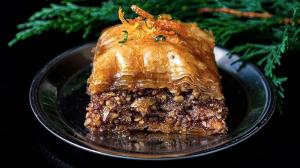Making a traditional walnut BAKLAVA even better is easier than you think because it’s all about the choice of the complementary flavors that will be added to accentuate and simultaneously brighten up this very sweet, buttery and crunchy holiday dessert !
It’s true that I do have a preference for hand-held or individual format desserts which is why I often prepare rolled baklava cigars instead of these sliceable baklava squares but perhaps the holiday season with its fancier table and place settings and cutlery requires a dessert that can be daintily set upon a plate and enjoyed with a fork and knife.
Even though the overall taste of this baklava resembles my rolled baklava cigars (see recipe here), I chose to use only walnuts this time, as Greek tradition dictates, but I kept the added aromatics mixture I prefer, to lift and brighten up the overall flavor of this very sweet and buttery dessert.
It's true that the assembly may seem complicated for a novice, since it’s a layered dessert, but it’s all about the baked filo sheets meeting the spiced walnut filling and everything, once baked and still hot, meeting the cooled aromatic soaking syrup and becoming what it is.
A little helpful note, adding those 2 layers of filo in between the filling layers or even shredding the middle filo layers and adding it to the filling to create only one filling layer, will help to keep the baklava more solid and stable as you slice into it while enjoying it, instead of the layers slip-sliding everywhere.
Another detail, the weight of the amount of syrup needed to soak the baked baklava should be equal to the weight of the baked baklava and if you want the baklava to have an even shinier and glazed surface, then drizzle some extra honey on top after soaking it, when it’s still hot.
I was wondering, when you’re preparing your festive feasts, even if the traditional recipe is reinterpreted or modified to better correspond to our times, are you often transported by memories of your (or your friends’) parents and/or grandparents who took the time to prepare these dishes ?
Holiday cooking often resembles a culinary voyage back in time and the understanding of its importance and impact, then and now.
Happy Holidays and see you all next year, wishing you PEACE, LOVE, HEALTH, SUCCESS and above all, MODERATION, to make it all possible … :)














